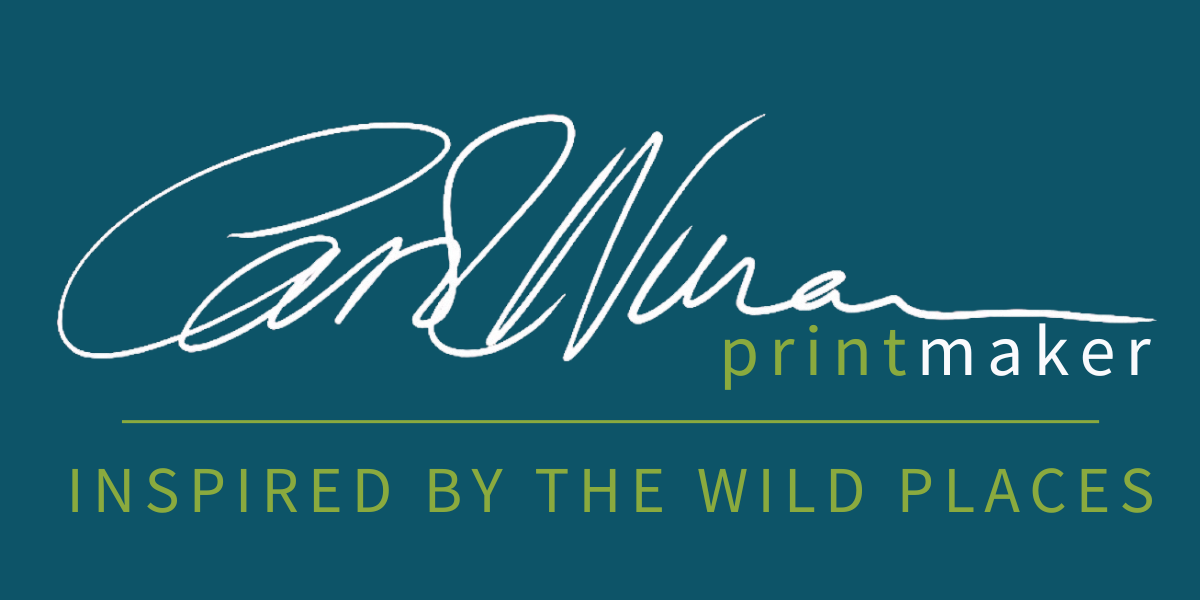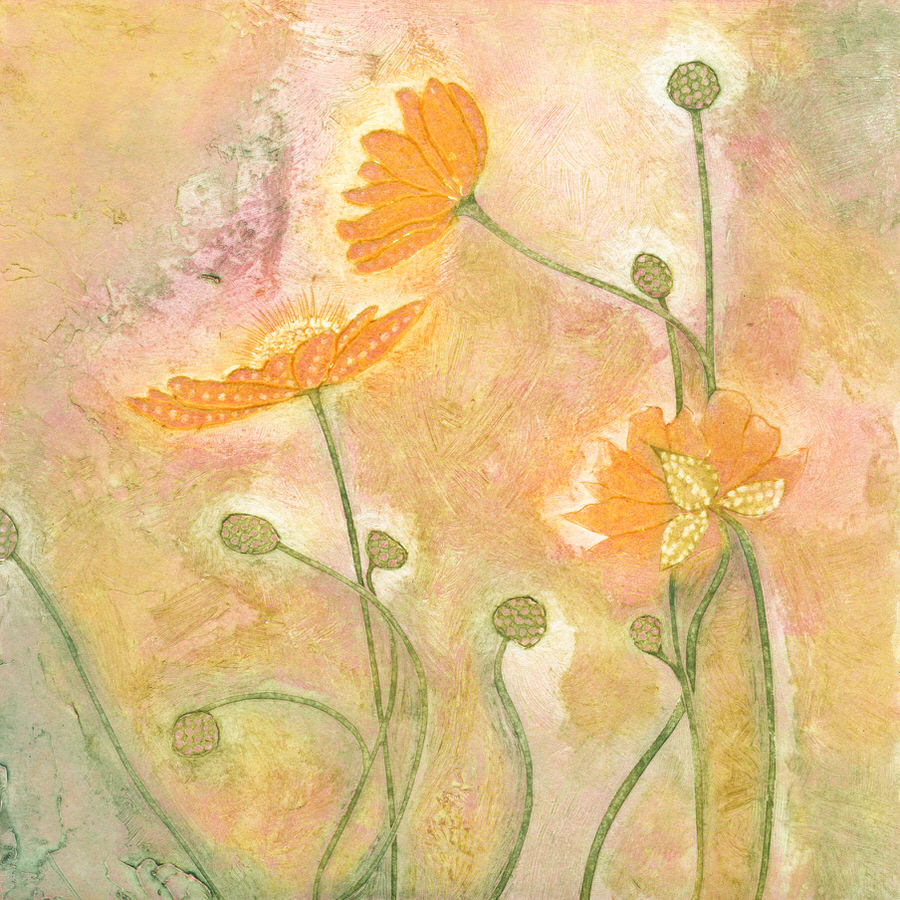A Brief Explanation of Different Printmaking Terms
A Brief Explanation of Different Printmaking Terms
Some of you may be unfamiliar with the printmaking terminology I use on my website and you may be wondering what printmaking entails so i thought I would provide a brief summary of the different terms to help you negotiate your way around. You will find more in-depth explanations in other blog posts for the printmaking media I use most frequently. In the fullness of time I will gradually add new blog posts about my own approach to the media of printmaking.
MONOTYPE
Monotype is the print equivalent to painting. Ink is ‘painted’ onto a smooth flat surface, like a metal or Perspex plate. This can be done with rollers (brayers), brushes, card, fingers, etc., and then transferred to paper through an etching press. There is no fixed matrix therefore any resulting print is a unique, ‘one-off’. There are a variety of techniques in this process. As there is no fixed matrix, it impossible to achieve duplicates. The artist will sign such a print with 1/1 or U/P (Unique Print) indicating it is a one-off print and not part of a limited edition.
MONOPRINT
On the other hand a monoprint is a printmaking process by which the artist varies the colours and tonal arrangements of an existing matrix. This can be created using any printmaking process - etching, linocut, collagraph, etc. Although the compositional matrix remains constant, each impression is obviously different in colour and/or tone leading to a variable edition. The artist signs it 1/1 which means there is only one print of that type or V/E (Variable Edition) or E/V (Edition Variable) which means it is part of an edition where the prints in the edition vary.
COLLAGRAPH
A collagraph is the printed result of a collage using a variety of textured materials that are glued or painted onto a thin base and printed as a combination relief*/intaglio** plate. Such materials include found materials that are flat(ish) - grasses, dried flowers, feathers, lace, textured wallpapers, textiles, etc. The resulting prints are very textural and embossed into the paper.
The plate substrate can be any of the following materials: Mountboard, thin wood ply, metal or Perspex sheeting.
Each substrate has it’s own unique characteristics. For example, with mount-board, layers of paper can be stripped from the surface to create textured areas of various depths; the wood grain can be utilized using wood ply and it can be carved into, metal or Perspex can be scratched into to make marks and so on.
Collagraph plates have permanent marks which allow the printmaker to make editions, of more than one. The smaller the edition the more valuable the print. The prints in the edition are not necessarily printed in one session. The printmaker will make an Artist Proof (A/P). This acts as the printmaker's guide for all subsequent prints in the edition. Each one is inked up and printed by hand.
CARBORUNDUM PRINTS
This is a form of collagraph. The areas that hold the ink are created by gluing powdered silicon carbide (carborundum) to the plate with glue or epoxy resins. Different gauges of silicon carbide enable the production of darker or lighter tones. There are a number of different approaches to making a carborundum print. Glue (or gesso) can be painted onto the plate and while it is wet, carborundum can be sprinkled across the surface lightly or heavily and left to dry. The excess is tapped off either before it dries or when everything is dry. Alternatively, carborundum can be mixed into the glue/gesso in a variety of ratios and painted directly onto the plate. If using a water soluble PVA the plate may need to be sealed before ink can be applied and a print taken from the plate. The resulting matrix can be printed as a combination relief*/intaglio** plate.
*RELIEF PRINTMAKING
Collagraphs, linocuts, wood cuts, wood engraving or any printmaking using a plate with a raised surface are relief prints. This means the ink is applied to the areas of the plate that stand up in relief to the rest of the plate. Some types of printmaking incorporate both relief and intaglio methods.
**INTAGLIO PRINTMAKING
Etching, photo etching, dry point, mezzotint, and collagraphs are all printmaking media that incorporate intaglio. The term ‘intaglio’ comes from the Italian word intagliare, meaning “to incise.” In this technique, acid, salt mordents, as in etching or photo-etching, or abrasive material and a sharp pointed tool (as in dry point) are used to incise textures into a flat plate. The plate may be made of copper, steel, iron, zinc, polycarbonate, or mountboard. The lines and tones of the printed image are dependent on these textured areas. The plate is covered with ink, and then wiped so that only the incised, or textured areas contain ink. The pressure of the printing press forces dampened paper into the lower recesses of the plate where they pick up the ink. The plate leaves an indentation in the paper or plate-mark, which appears around the edges of the image area. This is the best way to tell if you are looking at an original print of any kind.
The different types of intaglio prints are distinguished by the technique used: etching, aquatint, and photogravure are made using a corrosive solution to form lines and textures in a metal plate, whilst engraving, drypoint and mezzotint are made using a sharp tool to incise, or scratch, the surface of the plate. Collagraphs are made using glue and textured materials stuck to the plate surface. Often several different intaglio techniques are used in the same print to achieve variations in contrast and tone.
DRYPOINT
This is a form of intaglio printmaking whereby the image is incised into the surface of a smooth plate - copper, aluminium, steel or clear perspex - with the use of a sharp needle tool. The advantage of using perspex, for those who lack confidence in their drawing skills, is that an image can be 'traced' through the clear perspex. I’ve used drypoint with some of my collagraphs such as ‘Edge of Empire’.
CHINE COLLÉ
French for Chinese Collage, it is a technique in printmaking, that involves bonding a light weight paper - tissue, Japanese paper, printed paper for example, to a heavier support paper during any of the above printmaking processes. One purpose is to allow the printmaker to print on a much more delicate surface, such as Japanese paper or linen, that pulls finer details off the plate or to add blocks of flat colour. This technique can be used in conjunction with any of the aforementioned printmaking media. I’ve used it from time to time in some of the work I’ve made in the past.
So there you have it, a brief explanation of some of the printmaking terms and techniques I have been know to use in my own work.






